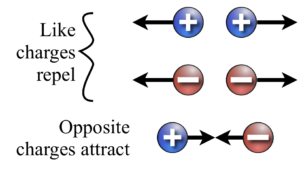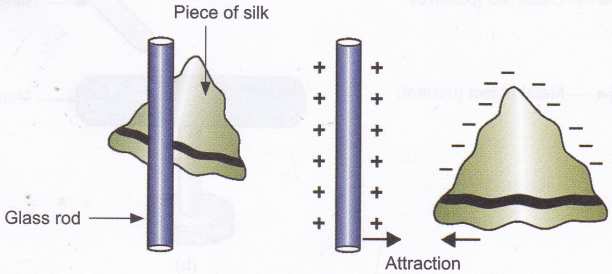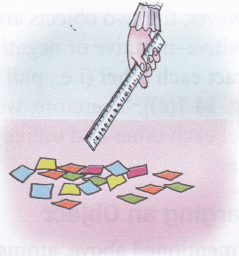What are the Three Ways to Charge an Object
The positively charged particles in an atom are called protons. The negatively charged particles are called electrons. Usually, the atom as a whole consists of an equal number of positive and negative charges, and in such a case the atom is said to be electrically neutral. If, however, the charges are not balanced, the object will have an electric charge (positive charge if protons are more in number than electrons and negative charge if electrons are more in number than protons).
 If two objects having the same type of charge (i.e., positive-positive or negative-negative) are brought close together, they repel each other (i.e., push each other away) [Figs (a) and (b)]. If, however, the two objects are oppositely charged (positive-negative or negative-positive), they attract each other (i.e., pull towards each other) [Fig (c)]. Therefore, we can say, like charges repel each other and unlike charges attract each other.
If two objects having the same type of charge (i.e., positive-positive or negative-negative) are brought close together, they repel each other (i.e., push each other away) [Figs (a) and (b)]. If, however, the two objects are oppositely charged (positive-negative or negative-positive), they attract each other (i.e., pull towards each other) [Fig (c)]. Therefore, we can say, like charges repel each other and unlike charges attract each other.
Charging an Object
As mentioned above, atoms usually have equal number of positive and negative charges, and are, therefore, electrically neutral. This is the reason why most objects around us are electrically neutral. An electrically neutral object can be charged (i.e., given an electric charge) by using any of the following methods.
- Charging by friction: This kind of charging is done by rubbing one material with another. The most common examples are rubbing glass with silk, and ebonite (a kind of hard rubber) with wool. When a glass rod is rubbed with a piece of silk, negative charges are transferred from glass to silk. The glass rod is, therefore, left with a positive charge and the piece of silk acquires a negative charge.

Similarly, if an ebonite rod is rubbed with wool, negative charges go from the piece of wool to the ebonite rod. The ebonite rod becomes negatively charged and the piece of wool becomes positively charged.

- Charging by conduction: An object can also be charged by touching it to a charged body. For example, if we take a charged glass rod and touch it to a metal object, the metal object will also get a charge. This is called charging by conduction. The nature of the charge acquired will be the same as that of the charging body. In this case, the metal object will also get the same nature of charge (positive) as the glass rod.

- Charging by induction: In charging by induction, charging is done without touching the charged body to the object that has to be charged. For example, a charged glass rod is brought close to a metal object, but does not touch it.
Activity
Aim: To attract bits of paper using a charged ruler
Materials needed: A plastic ruler and tiny bits of paper
Method: Run the ruler through your hair several times. Then hold the ruler close to the pieces of paper.

Observation: The bits of paper are attracted to the charged ruler.
